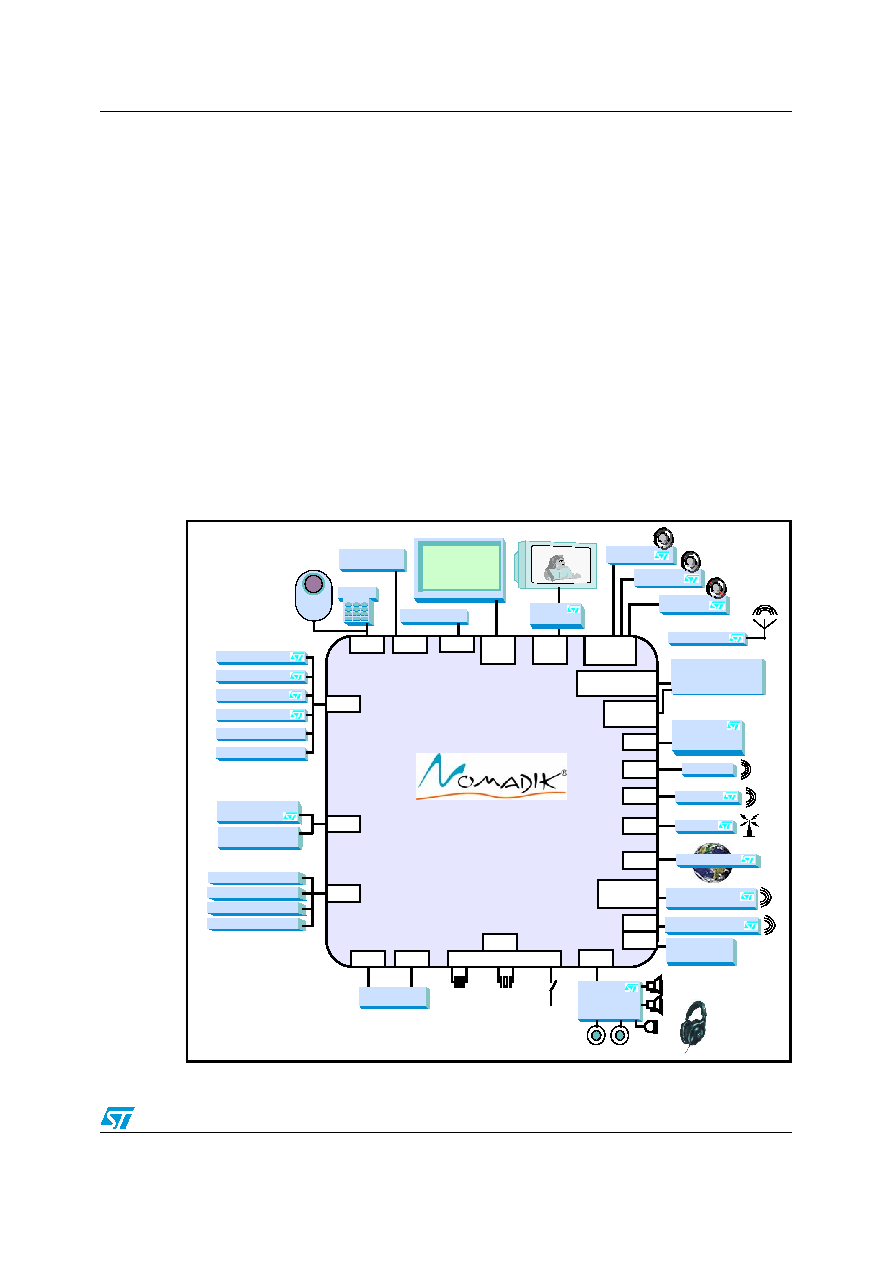 | ÐлекÑÑоннÑй компоненÑ: STN8815 | СкаÑаÑÑ:  PDF PDF  ZIP ZIP |
Äîêóìåíòàöèÿ è îïèñàíèÿ www.docs.chipfind.ru

Data Brief
For further information contact your local STMicroelectronics sales office.
February 2006
Rev 1
1/8
2
STn8815
Nomadik mobile multimedia application processor
Smart video accelerator
MPEG-4 SP real-time encoding/decoding
up to SDTV 30 fps
H.264/AVC real-time decoding up to VGA
30 fps and encoding up to VGA 15 fps
JPEG encode up to 30 Mpixel/s,
Ultra low-power implementation
Smart audio accelerator
Extensive digital-audio software library
Ultra low-power implementation
Smart imaging accelerator
2 SMIA CCP2 camera interfaces
Parallel camera CCIR-656 interface
Real-time image reconstruction up to
80 Mpixel/s
10-bit raw Bayer interface
Ultra low-power implementation
Smart graphics accelerator
Advanced power management unit
Run, idle, doze and sleep modes
CPU clock with programmable frequency
Enhanced dynamic power-domain
management
Dynamic voltage scaling
TV output
ARM926EJ
®
32-bit RISC CPU, up to 334 MHz
16-Kbyte instruction cache, 16-Kbyte data
cache
128-Kbyte level 2 cache
3 instruction sets: 32-bit for high
performance, 16-bit (Thumb) for efficient
code density, byte Java mode (JazelleTM)
for direct execution of Java code
Embedded medium trace module
(ETM Medium+)
On-chip SRAM and ROM
Advanced security
Enhanced security framework
Protected access to secured ROM and
RAM
16-bit DDR/SDR-SDRAM memory controller
(up to 166 MHz)
NOR Flash/NAND Flash/CompactFlash/CF+
controller
High-speed MMC/SD Card/SDIO/Memory
Stick Pro host controller
Color LCD controller for STN or TFT panels or
display interface for display module
24-bpp true color
MIPITM legacy DBI and DPI
PLLs
Power
management
Icache
Dcache
JTAG/trace
ARM926EJ
DDR SDRAM
controller
NAND/NOR Flash
controller
Multichannel DMA
controller
Secured
RAM/ROM
Watchdog
Timers
RTC
System
controller
Interrupt
controller
SSP
GPIO
UART x3
MSP x3
SD/SDIO/MMC/MS
FIrDA
TV output
Color LCD controller
Display interfaces
USB-OTG x2
Camera interface x3
HSI x2
Security toolbox
I²C x3
L2 cache
1-Wire/HDQ interface
Rotary encoder i/f
Keypad interface
Smart video
accelerator
Smart audio
accelerator
Smart imaging
accelerator
accelerator
Smart graphics
eSRAM
buffer
Host port interface
www.st.com
Nomadik is a registered trademark of STMicroelectronics

STn8815
2/8
Two high speed USB 2.0 On-The-Go controller interfaces
ULPI v1.1 compliance
ULPI DDR support
Host port interface
I/O peripherals
3 autobaud UARTs
IrDA (SIR/MIR/FIR) interface
Synchronous serial port (SSP)
3 multichannel serial ports (MSP)
3 I²C master/slave interfaces
Two 8-channel, full-duplex high-speed serial interfaces (MIPI legacy HSI)
Rotary encoder interface; keypad matrix interface
1-Wire®/HDQ interface
(a)
General-purpose I/Os (muxed with peripheral I/Os)
System and peripheral controller
Multichannel DMA controller
64-source interrupt controller
Timers/counters
Programmable PLL for CPU and system clocks
Two crystal oscillators:
32 kHz and 13/19.2 MHz
JTAG IEEE 1149.1 boundary scan
14 x 14 mm package for stacked and package-on-package versions
Pin-to-pin compatible with STn8810
a.
1-Wire is a registered trademark of Dallas Semiconductor.

STn8815
STn8815 overview
3/8
STn8815 overview
The convergence of computing, multimedia and mobile communications is well underway.
Already the familiar voice phone is being transformed into a personal device with a wide
range of multimedia capabilities. Soon mobile users will be able to benefit from a broad
spectrum of multimedia features and services, to include capturing, sending and receiving
images, videos and music. To deliver such data-heavy, processing-intensive services,
portable handheld systems must be optimized for high performance but low power, space
and cost.
In response to this need, the STn8815 processor platform from STMicroelectronics is a
culmination of breakthroughs in video coding efficiency, inventive algorithms and chip
implementation schemes. It will enable smart phones, wireless PDAs, internet appliances
and car entertainment systems to play back media content, record pictures and video clips,
and perform bidirectional audio-visual communication with other systems in real time.
The STn8815 focuses on the essential features to meet the future needs of mobile products
and services: a high-performance multimedia capability coupled with low power
consumption, and based on an open platform strategy.
Figure 1.
Typical system architecture using the STn8815
SDIO
MMC
SD-Card
Memory Stick Pro
Keypad
Low-power
Debug, trace
32 kHz 13/19.2 MHz
Reset
Audio
FM radio
GPS module
USB device
Bluetooth
Fast IrDA
GSM/GPRS/EDGE
xCDMA
modem chip set
RF
Touch screen
controller
LCD backlight
Energy
management
codecs
SDRAM
Mobile
DDR SDRAM
SDMC
MMCI
ETM9
JTAG
SKE
I²S
RTC
Clock, reset
UART
UART
I²C
I²C
FIrDA
USB-OTG
PWL
SSP
CLCD/
MDIF
Camera
interfaces
High-speed
serial interface
TFT
Mono/color STN
smart panel
Host port
interface
high speed
TV
output
CompactFlash/CF+
NAND Flash
NOR Flash
SRAM
ROM
ATA device
FSMC
802.11x WLAN
MSP
Rotary
wheel
STn8815
STw5095
Denc
STw4810
STw8009
MSP
Digital TV
demodulator
Camera1
Camera 2
Camera 3

Key benefits
STn8815
4/8
Key benefits
The STn8815 brings the following key benefits to mobile manufacturers and consumers:
Unsurpassed audio, video and imaging quality,
Ultra-low power consumption for longer battery operation,
Easier application development for shorter time-to-market,
Scalability for multiple market segments and future multimedia applications.
Main features
The STn8815 processor platform enables compelling multimedia applications by means of
its unique distributed-processing architecture.
The application processor features low-power smart accelerators which handle all audio,
video and graphics functions. These free the main CPU for control and program flow tasks,
or allow the CPU to enter power-saving modes to prolong battery life. The smart
accelerators operate independently and concurrently to ensure the lowest absolute system
power and deterministic high-performance.
The main features of the platform are:
A smart video accelerator for SDTV video encoding and decoding, with MIPI and SMIA
camera interfaces.
A smart audio accelerator containing a comprehensive set of digital audio decoders
and encoders, and offering a large number of 3-D surround effects.
A smart imaging accelerator, providing real-time, programmable image reconstruction
engine.
A smart graphics accelerator.
A dynamic, multi-mode power management unit.
The ARM926EJ processor, a powerful industry-standard CPU with Java acceleration.
On-chip ROM and SRAM memory devices, including a 3-Mbit frame buffer.
Security framework for enhanced mobile security, including stronger DRM.
Multichannel DMA controller for efficient data transfer without CPU intervention.
A multi-layer AMBA crossbar interconnect for optimized data transfers between the
CPU, accelerators, memory devices and peripherals.
Hardware semaphores for flexible inter-process management.
A wide range of peripheral interfaces (GPIO, USB-OTG high speed, UART, I²C, FIrDA,
SD/SDIO/high-speed MMC/Memory Stick Pro, fast serial ports, TV output, color LCD
and camera interfaces, scroll-key encoder, key-pad scanner).
Direct support for high-level operating system such as SymbianTM, Linux and WinCE®
operating systems (OSs).

STn8815
Low power consumption
5/8
Low power consumption
The new multimedia functionality of mobile products brings with it an increase in power
consumption that is outpacing advances in battery technology. The STn8815 chip saves on
power by avoiding the need for high clock speeds wherever possible, but its extremely low
power consumption results from a systematic effort at all design levels to reduce power
requirements. These include:
The use of smart accelerators and distributed processing to off load from the CPU,
Efficient code execution by means of innovative algorithms, energy-efficient instruction
set architectures and Java acceleration,
The efficient use of bandwidth for on-chip data transport, achieved by data
compression, buffering and image scaling,
Aggressive power management which includes turning off inactive parts of the chip and
keeping the CPU in power-saving modes as much as possible.
Open platform strategy
STMicroelectronics is a founding member of the MIPITM Alliance working towards mobile
software and hardware interface standards.
Our open platform strategy provides manufacturers with roadmap flexibility, allowing them to
avoid becoming locked into a proprietary CPU architecture or vendor technology. This
approach is facilitated by the following design points.
The STn8815 employs the third-party ARM® processor which is the standard CPU for
mobile devices, with industry-wide application support.
Open, standard APIs are provided for the development of application code on a level
which is abstracted from the physical hardware. This allows the development of
multimedia plug-ins that are portable between products and which can be reused on
future products without modification.
The STn8815 facilitates best-in-class algorithm development on its smart accelerators.
The STn8815 is provided with development kits and tools that speed-up the integration
of new operating systems, middleware, and signal processing algorithms.
Document Outline




